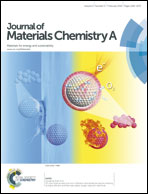Periodic mesoporous organosilicas for ultra-high selective copper(ii) detection and sensing mechanism†
Abstract
Using the novel bis(rhodamine Schiff-base derivative) bridged precursor with four silyl groups (BRh–Si4) and tetraethoxysilane as the organosilica source, bis(rhodamine Schiff-base derivative) bridged periodic mesoporous organosilicas (BRhPMOs) with mesoscopic and molecular scale periodicities are prepared through the supramolecular self-assembly of ionic liquid 1-hexadecyl-3-methylimidazolium bromide (C16mimBr). BRhPMOs with BRh units distributed uniformly in the framework, which show ultra-high selectivity towards copper ions, could be used as a Cu2+ fluorescence-ON chemosensor. The recognition mechanism of BRhPMOs towards Cu2+ has been investigated by Cu K-edge X-ray absorption fine structure spectroscopy (XAFS). The high selectivity of BRhPMOs towards Cu2+ can be attributed to the strong chelation of “N” atoms of the Schiff base in the BRh units to copper ions, leading to effective charge transfer between the BRh fluorophores and targeted metal ions. Owing to the encapsulation effect of the silica network, BRh chromophores in the form of BRhPMOs after chelating with copper ions exhibit higher photostability against long-term irradiation than rhodamine 6G (R6G) or Cu2+-chelated BRh–Si4, indicating their potential applications in biosensing and bioimaging. The perfect combination of functional fluorophores with periodic mesoporous organosilicas (PMOs) will open new avenues for applications in biotechnology and information technology.


 Please wait while we load your content...
Please wait while we load your content...